Troubled kids, powerful drugs
[See Part 1: Pennsylvania Juvenile Offenders Given Psychiatric Drugs at High Rates]
Pennsylvania is lagging when it comes to tracking the powerful psychiatric medications kids get in the state’s youth correctional facilities.
While other states have reformed the way they control and track such medications so that it is done systemwide, the Pennsylvania Department of Human Services follows only the total amount paid for the drugs prescribed in its six facilities on a systemic basis.
Everything else is looked at on an individual resident and facility basis. Experts and officials in other states say the fragmented approach reduces the department’s ability to see patterns and to plan effective programs.
 A PublicSource investigation found that psychiatric medications are being given at alarmingly high rates to the confined youth. The most powerful and risk-laden class of psychiatric drugs, the antipsychotics, was ordered in amounts that could treat an average of one-third of those in the state facilities at any given time over the seven years studied.
A PublicSource investigation found that psychiatric medications are being given at alarmingly high rates to the confined youth. The most powerful and risk-laden class of psychiatric drugs, the antipsychotics, was ordered in amounts that could treat an average of one-third of those in the state facilities at any given time over the seven years studied.
Among concerns about the levels of prescriptions is that the drugs can have serious side effects and may be used to keep kids in line.
The rate of antipsychotics prescribed in the state’s youth development centers and forestry camps is higher than that found for juveniles in foster care in Pennsylvania, where 22 percent were given antipsychotics in 2012, according to a study commissioned by the Department of Human Services (DHS).
The state and much of the nation is focused on stemming the high levels of psychiatric medications, also called psychotropic medications, used in foster care.
But other states have realized kids in the delinquency system often come from foster care or similar backgrounds. They have begun scrutinizing medications prescribed to both populations through the courts and the departments that oversee the facilities. In addition to tracking the meds, they have also established controls on prescribing.
 Experts see this as a crucial health matter for kids who are already slipping through the cracks.
Experts see this as a crucial health matter for kids who are already slipping through the cracks.
Robert Schwartz, co-founder of the Juvenile Law Center in Philadelphia, said the state needs a way to track variations in prescribing by doctors and facilities, the degree to which parents are involved in making decisions about treatment and the impact on kids, both foster and delinquent.
“It’s pretty clear that we do not have that system today,” he said of the state’s methods.
Review
The high-security juvenile system has been shrinking in recent years as the state moves away from placing kids in the rural facilities and invests in more community-based services.
The five youth development centers and forestry camps still open have 370 beds, but only about 270 kids were residing in the centers or camps as of Oct. 14. The sixth included in PublicSource’s analysis — the 52-bed Cresson Secure Treatment Unit in Cambria County — closed Sept. 30.
Thousands of young people, ages 12 to 20, spent time in the state facilities from 2007 through 2013. There were 606 beds in fiscal year 2007-08.
The department wrote that information on medications is maintained in individual juvenile files and monthly invoices.
“We physically do not have the system to pull this,” DHS spokeswoman Kait Gillis told PublicSource in a May 2014 phone call about the records requested. “The only aggregates we keep is the amount of money spent that has to go into the budget for how much money we spend on prescriptions.”
In a Sept. 26, 2015 email, Gillis wrote that “a review of medications and costs is conducted monthly by each health services site to monitor costs and quantity.”
She wrote that the reviews entail someone at each facility looking at costs as well as the medications and quantities given to each individual for “treatment plan management.”
The doctors and other health staff regularly monitor individual residents for how well medications are working and side effects, Gillis wrote.
Kid by kid
Melissa Sickmund, director of the Pittsburgh-based National Center for Juvenile Justice, leads several national data collection efforts on juvenile justice issues. Her job exists to collect and analyze data that can be used to make policy on state and federal levels.
Sickmund said the state could use aggregate data on prescribing to establish goals for the health care of all the kids they serve rather than only looking at each kid’s health issue in a silo.
“If you’re looking at one kid and one kid and one kid, you won’t even notice that you had that big jump, so you’re not ever going to ask yourself, ‘Why?’” she said.
The state would not discuss whether it has policies for prescribing psychotropics (a technical term for psychiatric medications).
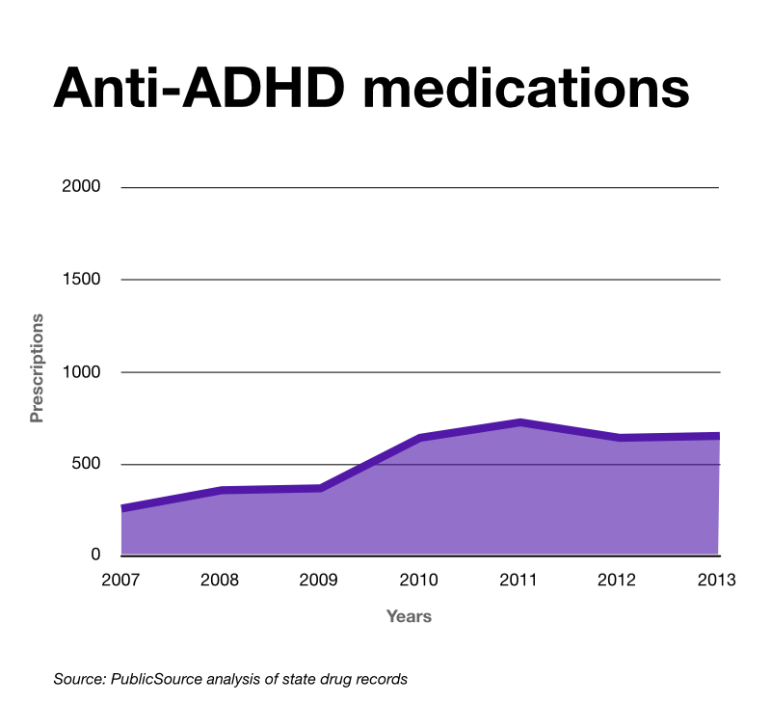
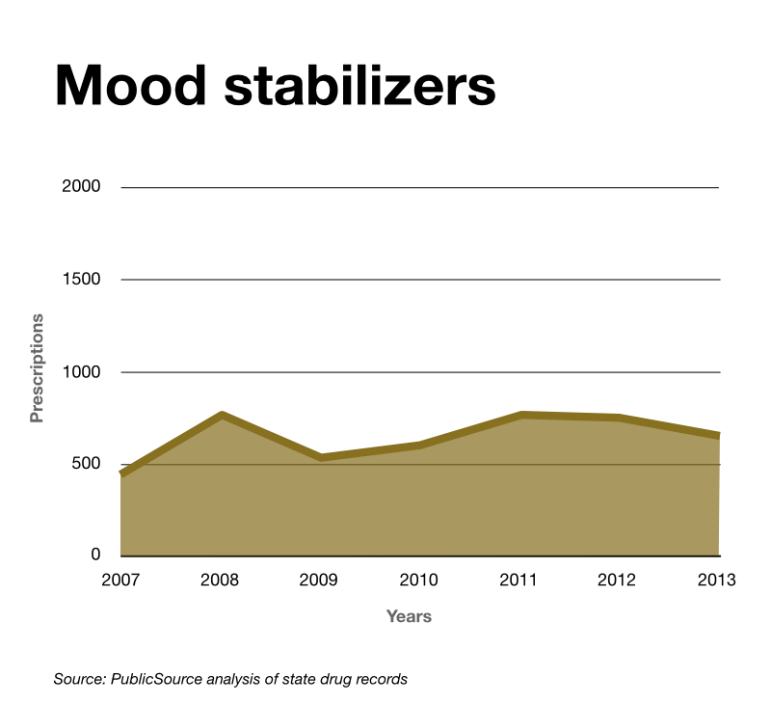
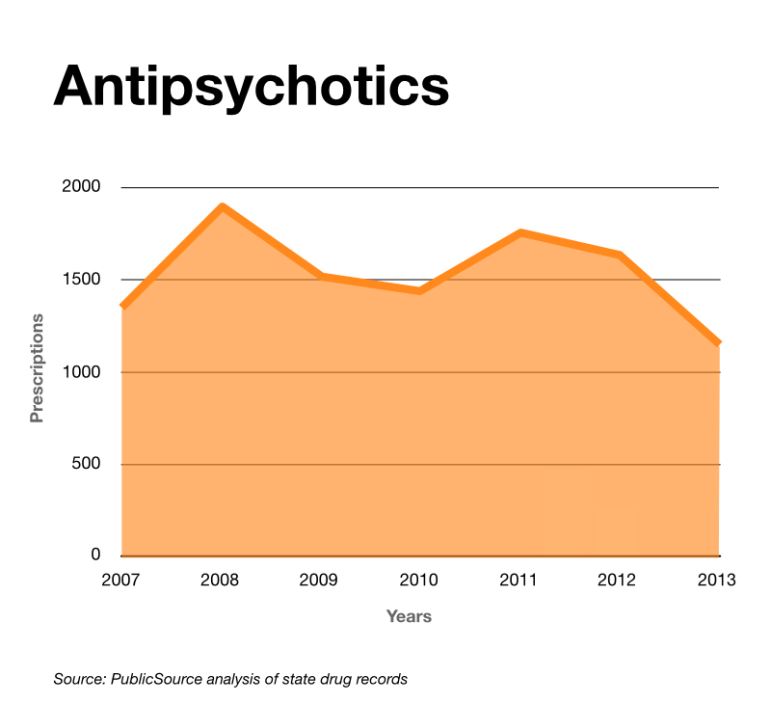
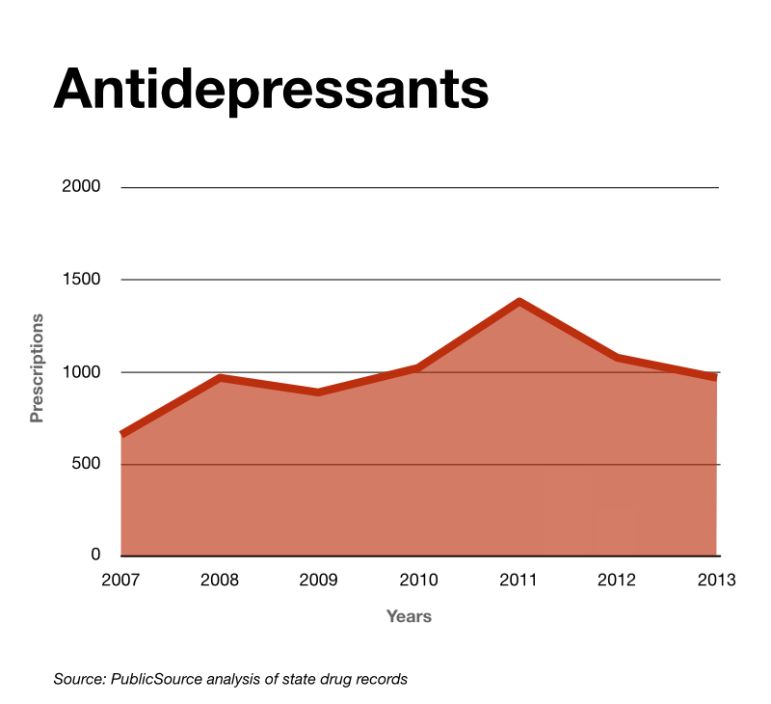
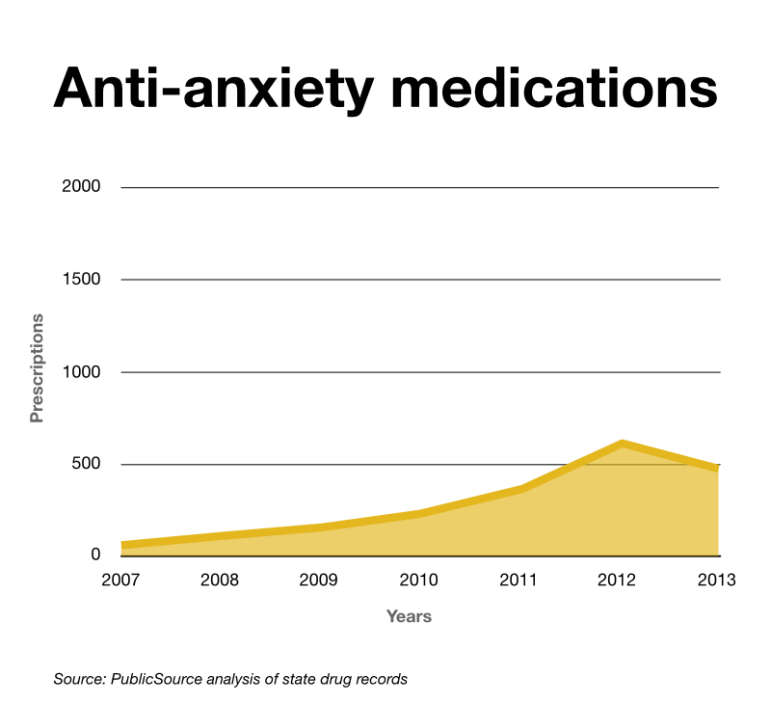
PolicyLab, a research arm of the Children’s Hospital of Philadelphia, released the DHS-commissioned study on prescribing to the state’s foster kids in June. There are many more children in foster care than in the youth correctional facilities. PolicyLab identified 18,400 youth who were in foster care at some point in 2012.
The department responded to that study by saying it would create an “electronic dashboard” to monitor the use of antipsychotics in foster youth.
Also in response to the study of foster children, DHS said it would create a consultation hotline for physicians who prescribe psychotropics to children, improve assessment tools and revise guidelines on treating children when parents cannot be reached in a timely manner to give consent.
Schwartz, of the Juvenile Law Center, said data collection of all kinds has put a strain on Pennsylvania state agencies, and it results in a lot of data not being collected at all.
“It’s not that it’s not doable, but it may be expensive,” he said. “It hasn’t been a priority, but many of us who work with kids think it should be.”
It has been a priority in other states, whose decisions could show the way to improve prescription monitoring for Pennsylvania juveniles.
In Colorado, a 2014 legislative audit of youth correctional facilities found high levels of psychiatric medication prescribed.
This July, Colorado’s Department of Human Services hired a medical director to oversee the use of psychiatric medications for both foster and delinquent youth.
The Colorado General Assembly dedicated nearly $745,000 to medical management oversight for this population, according to an email from Alicia Caldwell, the department’s spokeswoman.
Other groups and institutions that provide health care to children say that monitoring and data collection are crucial to running effective programs.
Hospitals use aggregate data to see what their clinicians are doing and to understand the population they’re serving, said Kathleen Noonan, founding co-director of PolicyLab.
“It helps you forecast where you’re going, and do you want to change?” she said.
Policies
In May 2011, the Palm Beach Post reported that Florida’s Department of Juvenile Justice didn’t track prescriptions or know why doctors were prescribing certain medications.
Around the same time, the department began considering a number of juvenile justice reforms, including prescribing practices. It has since become a leader in tracking and putting controls on medications in its juvenile justice facilities.
The state has electronic medical records in its detention centers that flag the use of psychotropic medications and allows health services to track and analyze them systemwide. The department is also implementing electronic medical records in its secure residential and correctional facilities, said Laura Moneyham, assistant secretary for residential services.
Since 2012, the department has conducted regular evaluations of psychiatric medication use. The Florida department shared with PublicSource its January 2014 findings broken down by program, region, drug type and other indicators. It showed 29 percent of the youth in the state’s various juvenile justice programs were on a psychiatric medication.
Moneyham said the department has not seen a “substantive change” in the percentage of kids on psychiatric medications since they began tracking.
Florida also codified existing policies in an administrative rule in June 2014, requiring prescribers to provide clinical justification in writing for the use of more than one psychiatric medication at a time and to obtain parental consent, verbal and written, every time a new psychiatric medication is prescribed, discontinued or changed.
The rule prohibits using psychotropic meds in an emergency to control behavior. It also says they can’t be used “as punishment, for staff convenience, discipline, coercion or retaliation.”
Texas has a similar policy in place, in which an independent review is triggered any time the medications are used in emergencies.
Judges’ roles
When Allegheny County Court of Common Pleas Judge Kathryn M. Hens-Greco began to hear juvenile dependency and delinquency cases years ago, she noticed kids showing up in her courtroom in what appeared to be a drugged haze.
Her concerns, which she raised at roundtable sessions of the Pennsylvania Supreme Court’s Office of Children and Families in the Courts, resulted in a working group. From 2011 to 2014, they evaluated the use of psychiatric medications among foster children.
Pennsylvania is more easily able to analyze prescribing for foster children because they are on Medicaid. Medicaid benefits are terminated or suspended when a youth is sent to a state facility.
“Without oversight, it’s a really bad problem for our kids,” said Hens-Greco. “With oversight, what we’re really asking is for people not to make the prescription pad the first choice of treatment.”
[Video: A judge’s expectations]
When a young person is sent to a correctional facility, it is not a sentence like you see in adult court; they are called commitments and the person’s time in the facility is up to interpretation, based on progress noted by caseworkers and judges at periodic review hearings.
The state working group developed a card for judges that provides questions for them to ask to help understand and regulate medication use among foster children and youth offenders.
Two years ago, the National Council of Juvenile and Family Court Judges, a Reno, Nevada-based nonprofit with a mission to improve the family court system, adopted a resolution creating protocols for judicial oversight of these medications.
According to the resolution, judges are expected to seek out what is being prescribed and why, alternatives that have been tried and the effects of the medication. It also calls on judges to ensure that there is monitoring and that parents and children have been fully informed about the medications.
In California, the Welfare and Institutions Code requires court authorization for psychiatric medications. A physician must submit a request with the reason for the medication, the child’s diagnosis, the goals of using the medication and a description of potential side effects.
The state’s governor this month signed into law even stronger protections for kids seen in juvenile court by requiring more information on medications be submitted to courts and by training court officials to recognize overprescribing.
The policy is decidedly more generic in Pennsylvania, where judges are required to see that juveniles are receiving “necessary treatment and services,” according to Keith Snyder, executive director of the Juvenile Court Judges’ Commission (JCJC), a state agency that advises juvenile courts.
JCJC is providing judges with education on mental health treatment to better determine what is necessary in the treatment of mental health issues, Snyder said. Mental health was part of a weekend training for juvenile court judges in October, he added.
“We are going to be encouraging the judges to get more hands-on and not just trusting the treatment provider to do what we think is right,” he said.
“We send kids to treatment programs, we expect them to get appropriate treatment, and now we need, I think, to pay closer attention to what's going on in these facilities and ask pointed questions to make sure these kids aren't being overprescribed.”
Coming Sunday: State won’t disclose names of doctors prescribing in youth corrections.
A George Polk Grant for Investigative Reporting and a grant from The Fund for Investigative Journalism helped fund this PublicSource project.
Reach Halle Stockton at 412-315-0263 or hstockton@publicsource.org. Follow her on Twitter at @HalleStockton.
Data work by Alexandra Kanik, Eric Holmberg and Stockton.
